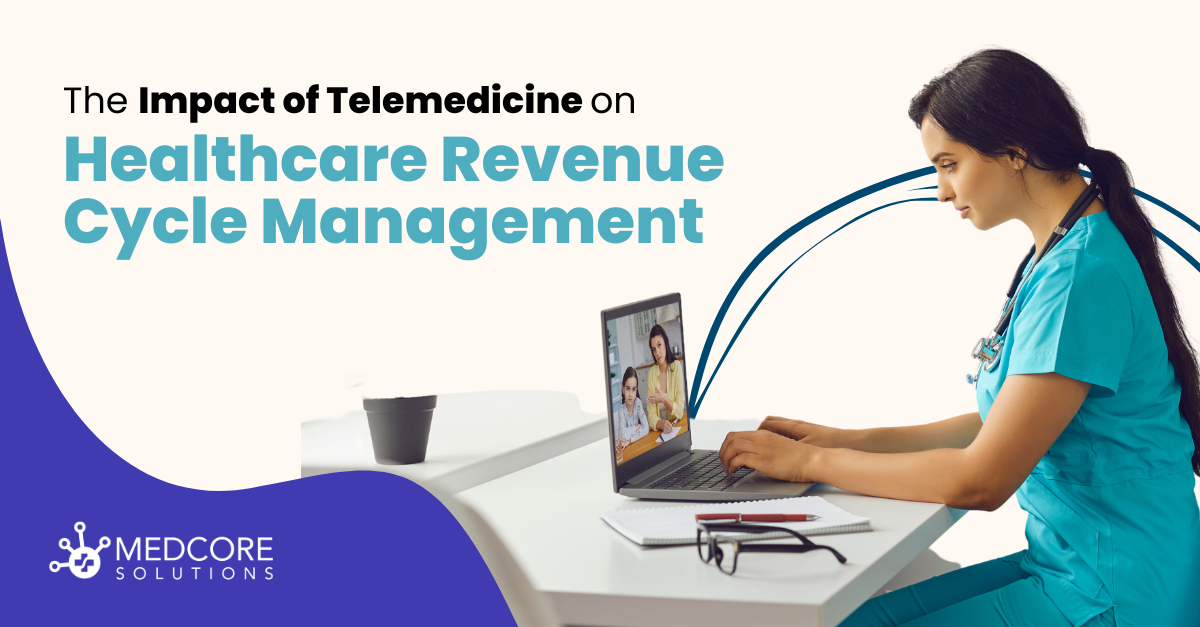Technological advancements continue to reshape RCM staffing and the healthcare industry in general. With this, telemedicine is also emerging as a transformative force. According to an ASPE research report, telehealth visits skyrocketed from approximately 840,000 in 2019 to an astounding 52.7 million in 2020, demonstrating an unprecedented adoption of remote healthcare services. With its ability to connect patients with healthcare providers remotely, telemedicine in RCM staffing is not only revolutionizing patient care. It is also significantly impacting healthcare revenue cycle management (RCM). Let’s delve into the profound effects of telemedicine on the revenue cycle. Explore how healthcare providers are leveraging this technology to streamline operations, enhance patient experiences, and optimize financial outcomes. Read on.
Understanding Healthcare Revenue Cycle Management

Before delving into the impact of telemedicine, it’s crucial to grasp the concept of healthcare revenue cycle management. The revenue cycle is all about the administrative and clinical functions that contribute to the capture, management, and collection of patient service revenue. It begins when a patient schedules an appointment and ends when the provider receives full payment for services rendered. RCM is composed of patient registration, insurance verification, coding and billing, claims processing, and reimbursement.
Challenges in Traditional Revenue Cycle Management
Traditional revenue cycle management processes are often plagued by inefficiencies, complexities, and administrative burdens. Manual tasks, such as paper-based documentation and manual claim submissions, are time-consuming and prone to errors. Insurance denials, delayed payments, and cumbersome reimbursement processes further exacerbate financial challenges for healthcare organizations. Additionally, the rise of high-deductible health plans has shifted more financial responsibility onto patients. This makes clear communication and transparency regarding healthcare costs more imperative.
The Telemedicine Revolution

Telemedicine, fueled by advancements in digital technology and increased connectivity, offers a solution to many of the challenges faced by traditional healthcare delivery models. By leveraging secure video conferencing platforms, electronic health records (EHRs), remote monitoring devices, and dedicated RCM staffing services, telemedicine enables healthcare providers to deliver timely, cost-effective care to patients regardless of their geographic location. From virtual consultations and remote diagnosis to medication management and follow-up visits, telemedicine empowers patients to access quality healthcare from the comfort of their homes.
How Healthcare Providers Can Adopt Telemedicine to Enhance Their Revenue Cycle Management (RCM)
Expand Patient Access
This convenience factor is particularly appealing to busy individuals, caregivers, elderly patients, and those with mobility limitations who may struggle to visit a healthcare facility in person. Telemedicine allows providers to reach patients in remote or underserved areas. It expands healthcare providers’ patient base, increasing revenue opportunities. By offering virtual consultations and follow-up appointments, providers can tap into new patient populations who may prefer the convenience and flexibility of virtual care. This includes tech-savvy millennials, busy working professionals, and individuals who value the privacy and comfort of virtual consultations.
Telemedicine also allows providers to keep a close eye on patients’ health status and intervene promptly if any issues arise. This ultimately prevents patients’ unnecessary hospitalizations and costly complications.
Reduce No-Shows and Cancellations
Allow patients to book consultations at times that are convenient for them. Telemedicine appointments are often more convenient for patients, leading to lower rates of missed appointments and cancellations. By reducing no-shows, providers can maximize their appointment capacity and optimize revenue generation.
Streamline Administrative Processes
Implementing telemedicine platforms with integrated scheduling, billing, and documentation functionalities can streamline administrative tasks. It reduces manual workloads for staff. Integrated telemedicine platforms allow for seamless scheduling of virtual appointments alongside traditional in-person visits. This unified scheduling system ensures that staff members can efficiently manage appointments without needing separate systems or manual data entry. With automated appointment reminders and confirmations, patients are more likely to attend their scheduled appointments. The rate of no-shows is reduced, maximizing appointment utilization.
Telemedicine platforms that integrate billing functionalities also streamline the billing process by automatically generating invoices and claims for telemedicine services rendered. By linking patient appointments with billing codes and insurance information, these platforms ensure accurate and timely billing submissions. This automation minimizes errors and reduces the time and resources required for manual billing tasks, ultimately accelerating the reimbursement process and optimizing revenue capture.
Additionally, integrated telemedicine platforms facilitate comprehensive documentation of patient encounters by capturing relevant clinical data, treatment plans, and follow-up instructions electronically. This electronic documentation ensures that all patient information is securely stored and easily accessible to authorized healthcare providers. By eliminating paper-based documentation processes and manual charting, staff members can devote more time to patient care and clinical activities, leading to increased productivity and efficiency. Other benefits of integrated telemedicine platforms that providers shouldn’t miss are real-time reporting and analytics and enhanced compliance and security.
This efficiency improvement can result in cost savings and increased productivity, ultimately benefiting the revenue cycle.
Adopt Value-Based Care Models
Telemedicine supports the transition to value-based care models by enabling providers to deliver proactive, continuous care to patients outside of traditional healthcare settings. By focusing on preventative care and chronic disease management through telemedicine, providers can improve patient outcomes while reducing costly hospital admissions and readmissions.
Engage Patients in Financial Responsibility
Telemedicine platforms can incorporate features such as online payment portals and cost estimators, empowering patients to understand their financial responsibilities upfront and make informed decisions about their healthcare services. By promoting transparency and patient engagement in financial matters, providers can enhance revenue cycle efficiency and reduce billing-related inquiries.
Conclusion

In conclusion, telemedicine is revolutionizing healthcare revenue cycle management by streamlining administrative processes. It expands access to care and optimizes financial outcomes for providers. By embracing telemedicine through effective RCM staffing, healthcare organizations can enhance patient experiences and improve operational efficiency. These improvements will drive revenue growth in an increasingly competitive marketplace. As telemedicine continues to evolve and gain widespread acceptance, its impact on the revenue cycle will become even more pronounced, shaping the future of healthcare delivery and financial sustainability.
Partner with MedCore and unlock the power of expert RCM staffing solutions tailored to your healthcare organization’s needs. Maximize efficiency, optimize revenue, and ensure compliance with our dedicated team of RCM professionals. Let’s transform your financial performance together–contact us today to learn more. Click here.

